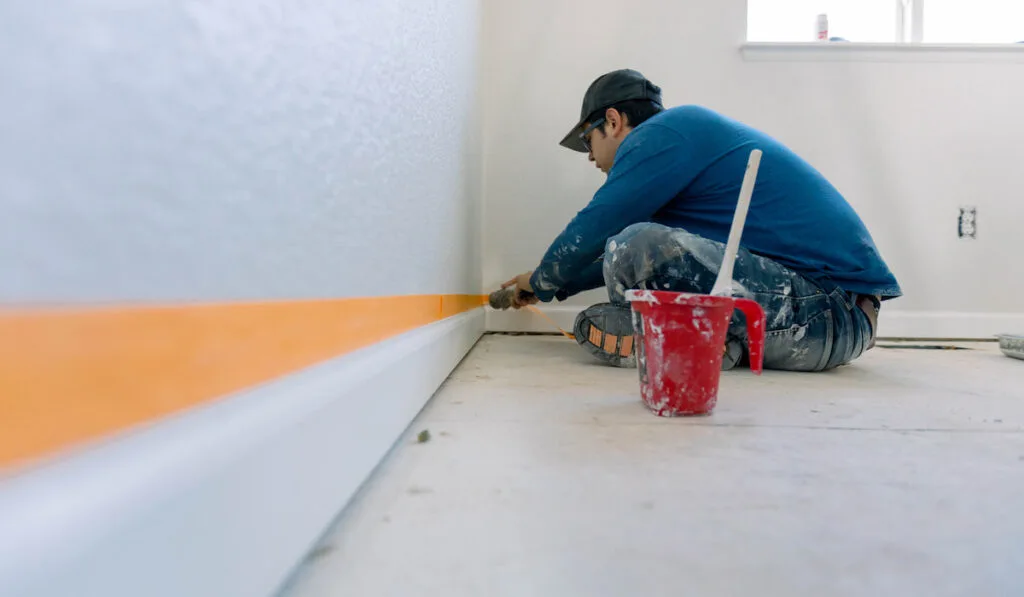*This post may have affiliate links, which means I may receive commissions if you choose to purchase through links I provide (at no extra cost to you). As an Amazon Associate, I earn from qualifying purchases. Please read my disclaimer for additional details.
Painting the trim around the interior of your home can provide it with a clean and vibrant look. And painting the baseboards is an easy way to update your space with a fresh appearance, but should trim be painted before installation?
In general, yes, it’s often helpful to paint your trim before installation as it can save you a lot of time, energy, and mess. But, there are some circumstances where it might be easier to install the trim first, particularly if you’re planning to paint the walls of your interior.

It’s like the age-old question, “Which came first: the chicken or the egg?” but with fewer chickens and more paint. To find the answer to this debate, plus the pros and cons of installing trim before and after painting, continue reading below.
Table of Contents
Should Trim Be Painted Before Installing?
Trim is the decorative molding that you apply to the room’s edges to give it a final aesthetic touch. Many different types are available, including baseboard, door, and window casings.
Each project and home is unique, so there’s no “one size fits all” when it comes to the process; it all depends on the work that you are doing.

That being said, many people will advise that you paint the trim before installing it, as this process can be much faster and easier.
This option is advantageous if you’ve already painted your walls to avoid dropping paint on walls or floors. You may have to do a few touch-ups once you install the wall, but these should be easy enough and use minimal time.
In addition, if you’re installing a high trim, you won’t need to work on a ladder for hours and hours to get your paint job complete.
Should Trim Be Painted After Installing?
If you opt to install the trim after installing it, you’ll need to have a careful hand and a good brush technique. Plus, you’ll need painter’s tape to avoid wall or floor splatter.
But, many people recommend this technique if you want a seamless finish on your painting. Painting the trim after installing it is also beneficial for people who don’t have the space to set up a painting bench elsewhere.
This option is best if the walls also need painting as you won’t need to worry about splashing paint onto the walls.
What Are The Advantages And Disadvantages Of Painted Trim Before You Install It?
| Advantages | Disadvantages | |
| Paint Trim Before Installing | You don’t have to worry about paint splatters on your walls or floors. Takes less time. Keeps excess moisture away from your walls and floors by allowing the paint to dry before installing. | You will have to do caulk and touch-ups after you have finished installing the trim. The painting you have already done may get chipped or scratched during installation. |
| Install Trim Before Painting | If the trim is already installed in your home, it may be easier to leave it in place for painting rather than trying to remove it. Allows you to caulk the gaps against the wall with paintable acrylic caulk. Can provide you with a neater finish when done correctly. | You’ll need a steady hand and a good brush technique to do a neat job. Takes more time. You will need to invest in painter’s tape or a similar method to protect your walls and floors. |
When Should I Paint Trim Before Installing?
Painting trim before installation is a good idea to protect it from moisture, leading to mold and rot.
Where possible, painting trim before installing is a great option to save time and avoid splashes. It’s easy to paint trim with a roller or spray, and you can focus your energy on the painting without worrying about walls or flooring.

When Should I Paint Trim After Installing?
Some people suggest that painting trim after it has been installed is the best way to go. And there are a couple of reasons for this.
While you’ll initially save time by painting the trim beforehand, you will have to touch up nails, caulk, and scratches once you have installed it. Whereas, if you install it, you only have to do your paint job once.
You’ll also want to install trim first when you don’t have enough space to set up a painting area. Ideally, you’ll need a sawhorse, plus a sufficient amount of space. If you don’t have enough space, it may be beneficial to paint after installation.

When Should I Remove Interior Baseboards?
It’s easy enough to remove a baseboard in a new home or one that has only experienced limited remodels; you should be able to pry them from the wall with a pry bar and your fingers.
You should always paint baseboards before installing them because it’s much easier (and cleaner) than trying to do it once you’ve installed the boards.
The paintwork may get a little damaged as you install the boards, but carrying out touch-ups will be much easier than painting the entire board once you’ve installed it.
When Should I Leave The Baseboards In Place?
If you’re looking to paint baseboards that your home already has installed, it may be easier to leave them in place.
In older homes, especially those with paint covering the baseboard-wall joint, it may be too difficult to remove the boards and could cause damage to the walls of your home.

Fastest Way To Paint Trim Before Installing
To paint trim quickly and efficiently, follow the steps below:
- Immerse the brush bristles into the paint to “fully load” the brush.
- Lightly tap the brush on the inside of the paint tin to eliminate any excess.
- Apply the paint to the trim in long, one-way strokes.
- Work from top to bottom if you’re working on a vertical trim.
- Allow drying completely.
- Gently sand, then reapply a second coat following the same steps.
Alternatively, you could purchase a pre-painted trim that is ready to install. This saves you painting time and mess.
These trims are available with non-metal-marking, water-based paint, which helps to prevent scuffs and scratches.
This means that it is less likely to be damaged during the installation process and is ideal for placing in a high-traffic area of your home.
What Are The Benefits Of Pre-Painted Trim?
One of the apparent benefits of pre-painted trim is that it can save hours of your time, and you won’t have to paint anything or wait for things to dry before moving on to the next step.
Plus, you won’t have any mess or splashes on the rest of your interior.
If you purchase a professional-grade product, it should possess a smooth finish with no brush marks, and many of these boards come with color-match touch-up kits so that you can obtain professional results if your trim is scuffed or marked.

Final Thoughts.
There is no right or wrong answer when deciding whether to paint or install your trim first; it ultimately comes down to personal choice. But there are a few factors you might want to consider.
If you’re only painting the trim, it’s easy to do it before installation to prevent splashes on finished walls and floors, but if you’re repainting the surrounding areas, you won’t need to worry about this. If time is your main concern, you’ll probably want to opt for paint first, but you can install it first if you don’t have the room.
Oh, and if you’re wondering – the egg came first, several million years before the chicken.
